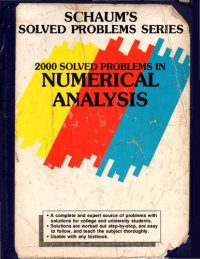
Ebook: 2000 Solved Problems in Numerical Analysis
Author: Francis Scheid
- Genre: Mathematics // Analysis
- Tags: Numerical Analysis
- Series: Schaum's Solved Problems Series
- Year: 1990
- Publisher: McGraw-Hill Publishing Company
- City: New York
- Edition: 1
- Language: English
- pdf
One of the great attractions of mathematics, to its devotees, may be that a well posed problem does in fact have
a unique and exact solution. This idea of absolute precision has a sort of beauty that in its own way is
unsurpassable. It may also be what frightens away many who feel more comfortable where there are shades of
gray. In numerical analysis we enjoy a little bit of both worlds but are much closer to the former than the latter.
The perfect solution is definitely out there somewhere in thought space, and knowledge of this fact has
sustained many a wearisome effort to get close to it. In what direction does it lie? How close to it are we now?
In the year 1225 Leonardo of Pisa studied the equation
x^3 + 2x^2 + 10x - 20 = 0
seeking its one real root, and produced x = 1.368808107. Nobody knows his method, but it is a remarkable
achievement for his time. Leonardo surely knew it was not perfection and may have wondered at the true
identity of the target number, but must have derived great pleasure from realizing how close he had come.
Numerical analysis problems do have exact solutions, but the thrill of victory does not wait for their discovery. It
is enough to come close. Error is expected. Without it we would be out of business. There is no need of
approximation where the real thing is within grasp. The following problems illustrate mathematics with some
controlled shades of gray. It has been a pleasure to work them through. I was almost sorry to come to the 2000th.
Though error is the substance of our subject, mistakes and blunders are not. I hope there are none, but experience
suggests otherwise. I will be grateful to anyone who takes the time to point them out, in the kinder and gentler way
that my now advanced years can withstand.
a unique and exact solution. This idea of absolute precision has a sort of beauty that in its own way is
unsurpassable. It may also be what frightens away many who feel more comfortable where there are shades of
gray. In numerical analysis we enjoy a little bit of both worlds but are much closer to the former than the latter.
The perfect solution is definitely out there somewhere in thought space, and knowledge of this fact has
sustained many a wearisome effort to get close to it. In what direction does it lie? How close to it are we now?
In the year 1225 Leonardo of Pisa studied the equation
x^3 + 2x^2 + 10x - 20 = 0
seeking its one real root, and produced x = 1.368808107. Nobody knows his method, but it is a remarkable
achievement for his time. Leonardo surely knew it was not perfection and may have wondered at the true
identity of the target number, but must have derived great pleasure from realizing how close he had come.
Numerical analysis problems do have exact solutions, but the thrill of victory does not wait for their discovery. It
is enough to come close. Error is expected. Without it we would be out of business. There is no need of
approximation where the real thing is within grasp. The following problems illustrate mathematics with some
controlled shades of gray. It has been a pleasure to work them through. I was almost sorry to come to the 2000th.
Though error is the substance of our subject, mistakes and blunders are not. I hope there are none, but experience
suggests otherwise. I will be grateful to anyone who takes the time to point them out, in the kinder and gentler way
that my now advanced years can withstand.
Download the book 2000 Solved Problems in Numerical Analysis for free or read online
Continue reading on any device:

Last viewed books
Related books
{related-news}
Comments (0)